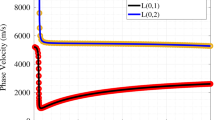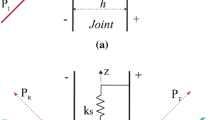Abstract
This paper presents a numerical simulation of S-wave propagation across a rough, filled discontinuity using the universal distinct element code (UDEC). The ability of UDEC to simulate a stress wave across a smooth and planar discontinuity filled with an elastic material is validated through comparisons with analytical solutions. Next, the effect of the plastic deformation of the fill on the wave propagation is investigated. The model is extended to further study S-wave propagation across a filled discontinuity with rough interfaces, which is described using a sawtooth. The transmission coefficient defined by the energy is used to measure the wave attenuation. Finally, a parametric study is conducted to investigate the influences of the filled thickness, asperity angle, and incident amplitude on the transmission waves and transmission coefficients. The asperity angle and filled thickness together determine the transmitted waveform and transmission coefficient. The transmitted wave may be cut off when the incident wave amplitude exceeds a threshold value. The transmission coefficient decreases with a different trend with the incident wave amplitude increasing when the asperity angle varies. Compared with planar discontinuity, a filled discontinuity with rough interfaces is more sensitive to the amplitude of the incident wave. The causes of these phenomena are analyzed in detail. In addition, the deformation of the fill material is strongly related to the wave attenuation.










Similar content being viewed by others
References
Babanouri N, Mansouri H, Nasab SK, Bahaadini M (2013) A coupled method to study blast wave propagation in fractured rock masses and estimate unknown properties. Comput Geotech 49:134–142. doi:10.1016/j.compgeo.2012.11.008
Barton N (1973) Rock mechanics review, the shear strength of rock and rock joints. Int J Rock Mech Min Sci 13:255–279
Bedford A, Drumheller DS (1994) Introduction to elastic wave propagation. Wiley, Chichester
Cai JG, Zhao J (2000) Effects of multiple parallel fractures on apparent attenuation of stress waves in rock masses. Int J Rock Mech Min Sci 37:661–682. doi:10.1016/S1365-1609(00)00013-7
Chen SG, Zhao J (1998) A study of UDEC modelling for blast wave propagation in jointed rock masses. Int J Rock Mech Min Sci 35:93–99. doi:10.1016/S0148-9062(97)00322-7
Cook NGW (1992) Natural joints in rock: mechanical, hydraulic and seismic behaviour and properties under normal stress. Int J Rock Mech Min Sci 29:198–223. doi:10.1016/0148-9062(92)93656-5
Cundall PA (1971) A computer model for simulating progressive large scale movements in blocky rock systems. In: Proceedings of the International Symposium on Rock Mechanics, Nancy, France, pp 11–18
Deng XF, Zhu JB, Chen SG, Zhao J (2012) Some fundamental issues and verification of 3DEC in modeling wave propagation in jointed rock masses. Rock Mech Rock Eng 45:943–951
Desai CS, Zaman MM, Lightner JG, Siriwardane HJ (1984) Thin-layer element for interfaces and joints. Int J Numer Anal Methods Geomech 8:19–43. doi:10.1002/nag.1610080103
Eberhardt E, Thuro K, Luginbuehl M (2005) Slope instability mechanisms in dipping interbedded conglomerates and weathered marls—the 1999 Rufi landslide, Switzerland. Eng Geol 77:35–56. doi:10.1016/j.enggeo.2004.08.004
Fehler M (1982) Interaction of seismic-waves with a viscous-liquid layer, vol 72. Bull Publishing House Seismol Society, Amer pp 55–72
Goodman RE, Taylor RL, Brekke TL (1968) A model for the mechanics of jointed rock. J Soil Mech Found Div ASCE 14:637–659
Huang X, Qi S, Williams A, Zou Y, Zheng B (2015) Numerical simulation of stress wave propagating through filled joints by particle model. Int J Solids Struct 69–70:23–33. doi:10.1016/j.ijsolstr.2015.06.012
Indraratna B, Haque A (1997) Experimental study of shear behavior of rock joints under constant normal stiffness conditions. Int J Rock Mech Min Sci 34:141.e1–141.e14. doi:10.1016/S1365-1609(97)00068-3
Indraratna B, Welideniya HS, Brown ET (2005) A shear strength model for idealised infilled joints under constant normal stiffness. Géotechnique 55:215–226. doi:10.1680/geot.2005.55.3.215
Jaeger JC, Cook NGW, Zimmerman R (2009) Fundamentals of rock mechanics. Wiley-Blackwell, London
Jahanian H, Sadaghiani MH (2015) Experimental study on the shear strength of sandy clay infilled regular rough rock joints. Rock Mech Rock Eng 48:907–922. doi:10.1007/s00603-014-0643-4
King MS, Myer LR, Rezowalli JJ (1986) Experimental studies of elastic-wave propagation in a columnar-jointed rock mass. Geophys Prospect 34:1185–1199. doi:10.1111/j.1365-2478.1986.tb00522.x
Kutter HK, Raunterberg A (1979) The residual shear strength of filled joints in rock. In: Proceedings of the Fourth Symposium of ISRM, pp 221–227
Lama RD (1978) Influence of clay fillings in shear behaviour of joints. In: Proceedings of the Third International Conference of International Association of Engineering Geology, pp 27–34
Lei WD (2011) A new method for processing wave amplitude for numerical analysis in rock dynamics. Int J Rock Mech Min Sci 48:674–680. doi:10.1016/j.ijrmms.2011.01.006
Lei WD, Hefny AM, Yan S, Teng J (2007) A numerical study on 2-D compressive wave propagation in rock masses with a set of joints along the radial direction normal to the joints. Comput Geotech 34:508–523. doi:10.1016/j.compgeo.2007.01.002
Li J, Ma G, Huang X (2010) Analysis of wave propagation through a filled rock joint. Rock Mech Rock Eng 43:789–798. doi:10.1007/s00603-009-0033-5
Li JC, Li HB, Ma GW, Zhao J (2012) A time-domain recursive method to analyse transient wave propagation across rock joints. Geophys J Int 188:631–644. doi:10.1111/j.1365-246X.2011.05286.x
Li JC, Liu TT, Li HB, Liu YQ, Liu B, Xia X (2015) Shear wave propagation across filled joints with the effect of interfacial shear strength. Rock Mech Rock Eng 48:1547–1557. doi:10.1007/s00603-014-0662-1
Li H, Liu T, Liu Y, Li J, Xia X, Liu B (2016) Numerical modeling of wave transmission across rock masses with nonlinear joints. Rock Mech Rock Eng 49:1115–1121. doi:10.1007/s00603-015-0766-2
Lyser J, Kuhlemeyer G (1969) Finite dynamic model for infinite media. J Eng Mech Div 4:859–876
Miller RK (1978) The effects of boundary friction on the propagation of elastic waves. Society (Am) 684:987–998
Miščević P, Števanić D, Štambuk-Cvitanović N (2009) Slope instability mechanisms in dipping conglomerates over weathered marls: Bol landslide, Croatia. Environ Geol 56:1417–1426. doi:10.1007/s00254-008-1236-x
Nakagawa S, Nihei KT, Myer LR (2000) Shear-induced conversion of seismic waves across single fractures. Int J Rock Mech Min Sci 37:203–218. doi:10.1016/S1365-1609(99)00101-X
Papaliangas T, Hencher SR, Lumsden AC, Manolopoulou S (1993) The effect of frictional filled thickness on the shear strength of rock discontinuities. Int J Rock Mech Min Sci 30:81–91. doi:10.1016/0148-9062(93)90702-F
Pereira JP (1997) Rolling friction and shear behaviour of rock discontinuities filled with sand. Int J Rock Mech Min Sci 34:244.e1–244.e17. doi:10.1016/S1365-1609(97)00037-3
Pyrak-Nolte LJ, Myer LR, Cook NGW (1990a) Transmission of seismic waves across single natural fractures. J Geophys Res 95:8617–8638. doi:10.1029/JB095iB06p08617
Pyrak-Nolte LJ, Myer LR, Cook NGW (1990b) Anisotropy in seismic velocities and amplitudes from multiple parallel fractures. J Geophys Res 95:11345–11358. doi:10.1029/JB095iB07p11345
Resende R, Lamas LN, Lemos JV, Calçada R (2010) Micromechanical modelling of stress waves in rock and rock fractures. Rock Mech Rock Eng 43:741–761. doi:10.1007/s00603-010-0098-1
Schoenberg M (1980) Elastic wave behavior across linear slip interfaces. J Acoust Soc Am 68:1516–1521. doi:10.1121/1.385077
Toomey A, Bean CJ (2000) Numerical simulation of seismic waves using a discrete particle scheme. Geophys J Int 141:595–604. doi:10.1046/j.1365-246x.2000.00094.x
Wu W, Zhu JB, Zhao J (2013) A further study on seismic response of a set of parallel rock fractures filled with viscoelastic materials. Geophys J Int 192:671–675. doi:10.1093/gji/ggs055
Zhao J, Zhao XB, Cai JG (2006) A further study of P-wave attenuation across parallel fractures with linear deformational behavior. Int J Rock Mech Min Sci 43:776–788. doi:10.1016/j.ijrmms.2005.12.007
Zhao XB, Zhao J, Cai JG, Hefny AM (2008) UDEC modelling on wave propagation across fractured rock masses. Comput Geotech 35:97–104. doi:10.1016/j.compgeo.2007.01.001
Zhao J, Sun L, Zhu JB (2012) Modelling P-wave transmission across rock fractures by particle manifold method (PMM). Geomech Geoeng 7:175–181. doi:10.1080/17486025.2012.695402
Zhu JB, Zhao XB, Wu W, Zhao J (2012) Wave propagation across rock joints filled with viscoelastic medium using modified recursive method. J Appl Geophys 86:82–87. doi:10.1016/j.jappgeo.2012.07.012
Zhu JB, Deng XF, Zhao XB, Zhao J (2013) A numerical study on wave transmission across multiple intersecting joint sets in rock masses with UDEC. Rock Mech Rock Eng 46:1429–1442. doi:10.1007/s00603-012-0352-9
Acknowledgments
We would like to acknowledge the reviewers and the editor for their valuable comments and suggestions. This paper was financially supported by the National Natural Science Foundation of China (51609183), the Open Research Fund of State Key Laboratory of Geomechanics and Geotechnical Engineering, Institute of Rock and Soil Mechanics, Chinese Academy of Sciences (Z015005), and the project supported by Hubei Key Laboratory of Roadway Bridge and Structure Engineering (Wuhan University of Technology) (DQJJ201501).
Author information
Authors and Affiliations
Corresponding author
Rights and permissions
About this article
Cite this article
Liu, T., Li, X., Li, J. et al. Numerical study on S-wave transmission across a rough, filled discontinuity. Arab J Geosci 10, 249 (2017). https://doi.org/10.1007/s12517-017-3030-0
Received:
Accepted:
Published:
DOI: https://doi.org/10.1007/s12517-017-3030-0




